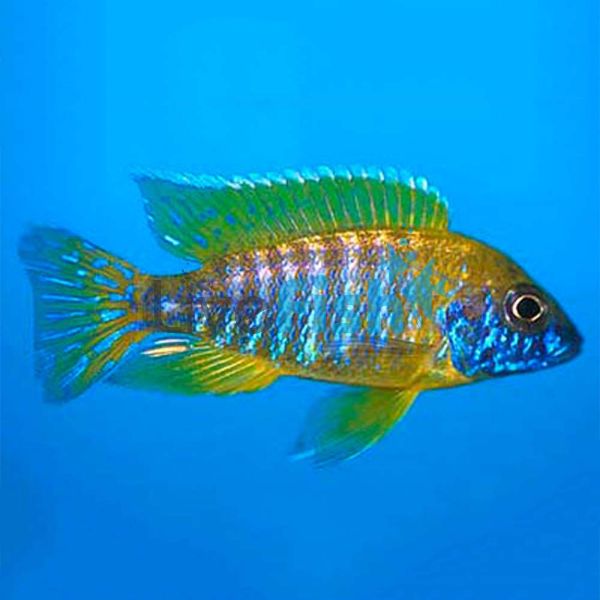Yellow Benga Peacock (German Strain) 5cm
Yellow Benga Peacocks just like many other African peacocks are one of the most brightly colored larger growing fish available in the aquarium hobby. Easily ranking in the leader board for its almost sulphuric yellow variations in the body and the bright blue cheek plate.
- Buy 4 for $42.66 each and save 20%
- Buy 6 for $37.32 each and save 30%
Yellow benga Peacock x
Yellow benga peacocks just like many other African peacocks are one of the most brightly colored larger growing fish available in the aquarium hobby. Easily ranking in the leader board for its almost sulphuric yellow variations in the body and the bright blue cheek plate. Unlike a lot of commonly available peacocks which have been selectively bred this color, variation is naturally occurring in the wild and it's easily confused with the sunshine peacock. Its colors are arguably better than most selective bred peacocks and even the sunshine which is also a strong yellow. The variations of yellow are the most striking in this fish where there are deep areas of strong and bright yellow with almost light stripes visible through the fish. It also has flame-like patterning of blue in the fins and a bright icy blue rim on its dorsal. The most contrasting area on this fish is where certain individuals have a deep blue cheek plate. The Benga peacock will get to around 17 cm (7 inches). African peacocks are commonly known to be semi-aggressive fish with aggression only coming out with territorial fights or breeding. Trying to find the males and females in African peacocks is fairly easy. The easiest method is to look at the egg spots on the anal fin of the fish. Males will have lots whereas females will have little to none, another common method is to look at the tips of the dorsal and anal fin. In males, these tend to be more pointed whereas in females they are rounded. The wild habitat of the Benga peacock is lake Malawi.
Tank Recommendations for your Benga Peacock Cichlid
The yellow benga peacock is a very active fish that needs a tank that is at least 125 gallons (470 liters) and around 4 feet minimum width. Sand or crushed coral substrate is fine for the red peacock but for the aquascape overall it would be best to replicate a rocky African lake biotope with rocks that increase the PH like Texas rock or Seriyu stone.
Suitable Tank Buddies
The benga peacock is fairly peaceful and can be kept with other color variations of the peacock species. Overstocking peacocks in aquariums is common to avoid aggression or territorial behavior however this can lead to more water changes and maintenance. This can be avoided by keeping minimal fish in a large aquarium with lots of visual breaks. Consideration can be made to keep them peaceful Mbunas and Haps.
Usually Compatible
Other African peacocks like dragon blood or neon blues and other common species such as electric yellow labs.
Sometimes Compatible
Larger haps such as venustus, Fuscodichromis, and small Africans such as julidochromis.
Rarely Compatible
Shrimp and nano aquarium fish like neon tetras, ember tetras, and also very aggressive South American cichlids such as Oscars and Jaguar Cichlids.
Feeding your Benga peacock
Benga Peacocks like other peacock cichlids are very easy to feed. It is an opportunistic feeder and will readily eat a wide range of foods being both dry, fresh, and frozen. Their diet should contain good quality African cichlid pellets with high contents of spirulina or greens. Feeding should occur once a day and it is best to do so during the day.
| Scientific Name | Aulonocara Baenschi |
|---|---|
| Care Level | Moderate |
| Common Names | New Regal Yellow peacock, Yellow peacock, benga peacock, baenschi peacock |
| Diet | Omnivore |
| Fish Family | Cichlidae |
| Lifespan (years) | 15 |
| Max. Length (cm) | 17 |
| Min. Tank Volume (l) | 470 Litres |
| Origin | Africa |
| Reef Safe | No |
| Sociability | Semi-aggressive |
| Venomous | No |
| Water Conditions | 24-26° C (75.2-79° F), pH 8.0-8.5 |




